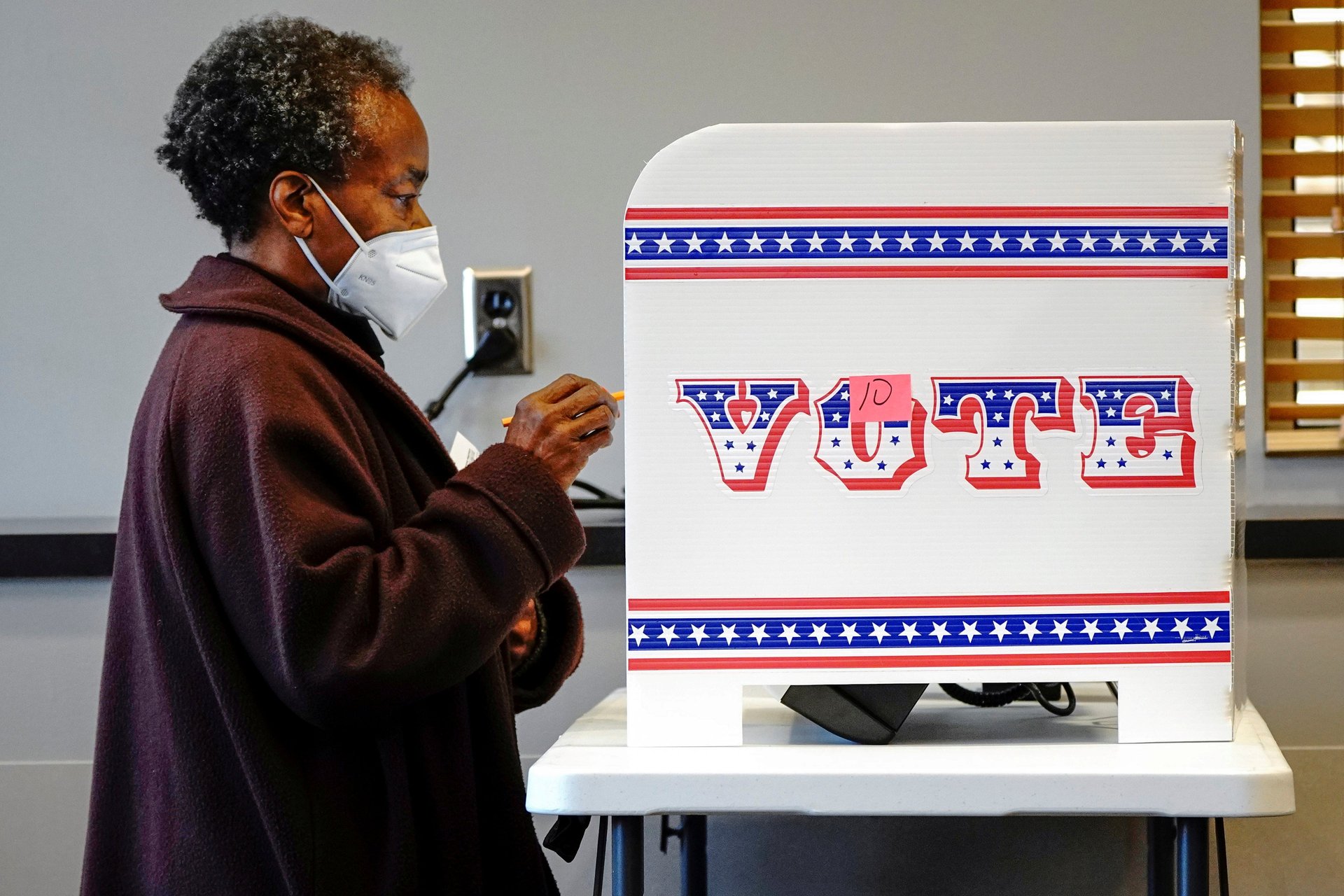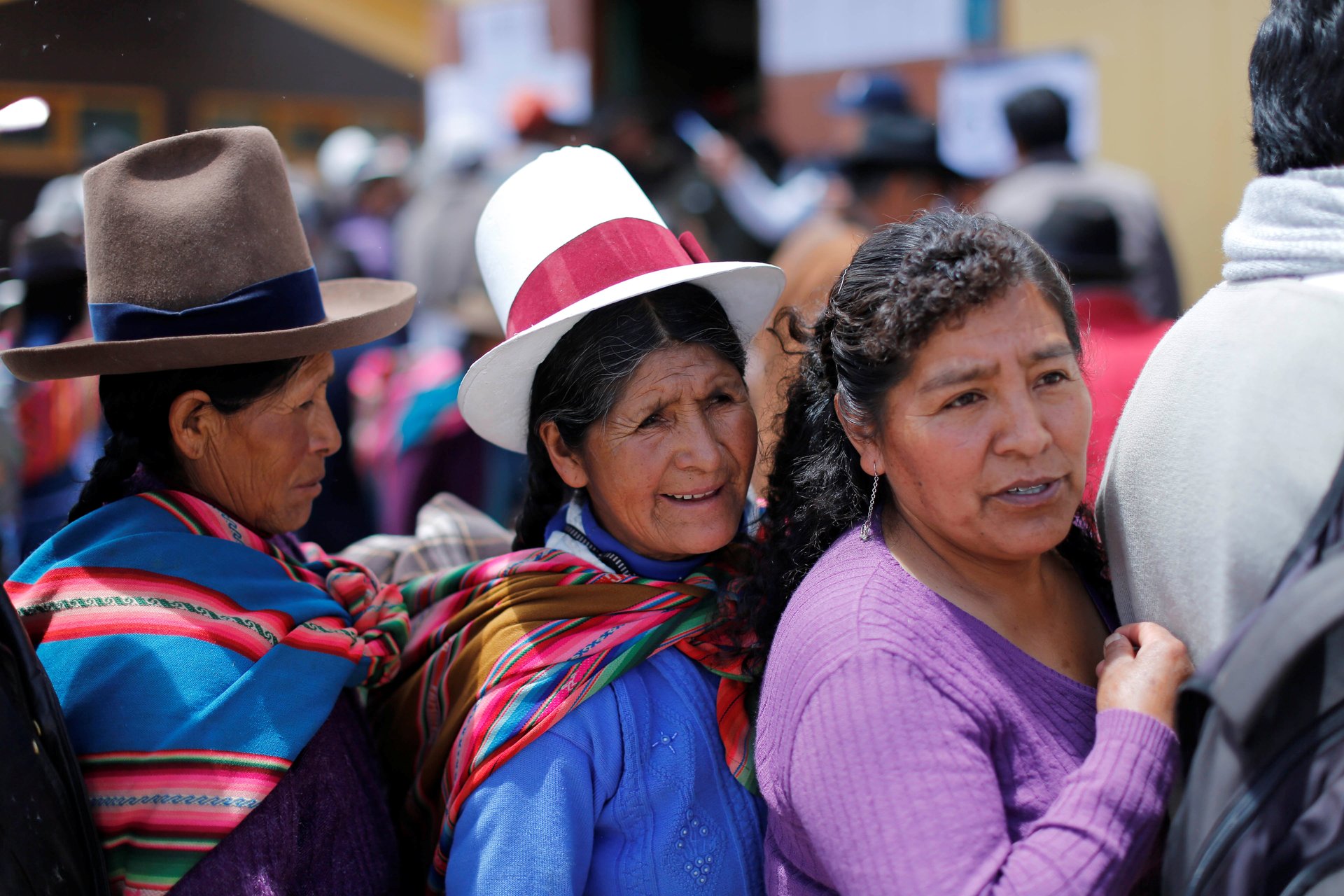Could compulsory voting save democracies in crisis?
By most metrics, there’s something wrong with how the US votes.


By most metrics, there’s something wrong with how the US votes.
Voter turnout is lower in the US than in most developed countries: It was 56% in the 2016 election, about the same as it’s been for the last few presidential elections. Political parties spend millions every election to convince voters to get to the polls. This election cycle, unsubstantiated voter fraud has been a campaign talking point, while voter suppression is a very real threat. On the Economic Intelligence Unit’s democracy index, the US ranks 25th.
In recent years, thinkers and academics have increasingly called for the public to consider compulsory voting as a way to heal the US’s electoral woes. In 2015, president Barack Obama advocated for voting to become compulsory in the US, on the grounds that it would “counteract money” in politics and increase the say of younger, more diverse, more progressive voters.
If the US did make the switch, it would join the ranks of 27 countries that currently require voting. The question is, are these countries better off because they mandate voting? Are their populations more engaged, their democracies stronger, their citizens better off? A growing body of literature has tackled these questions, and the answers aren’t straightforward.
Turning to the countries that have already tried compulsory voting can offer insight into which elements are successful—and how reforms shy of a mandate could still help solve the voting woes in the world’s democracies, including the US.
From desired to required
In 1892 Belgium became the first country to require eligible citizens (then only men) to vote. Over the centuries, the idea spread across Europe and around the rest of the world, including to Australia, Africa, and Latin America, where the idea has taken particular hold. Governments tended to adopt the laws as they were expanding laws around suffrage, and when it was politically expedient for the party in power.
Not all mandatory voting is created equal. While some countries only require registered voters to participate, others have automatic registration and so require ballot-casting for all. Countries also vary in how much they enforce their laws. While the fine applied to non-voters is easily waived in Australia, it can be pricey for folks in Peru; in Brazil, non-voters can be denied a passport. If Belgian voters don’t vote in four elections, they can lose their right to do so for 10 years.
Regardless of structure, though, scholars have found some commonalities in how compulsory voting changes a society. One clear impact: It increases voter turnout. A country that has laws requiring voting sees an average of 7% more election participation than those that don’t. Countries that change to voluntary elections might immediately see voter participation plummet, only to see it rise again later; Nicaragua, which sees 70% of its citizens show up to vote, got rid of compulsory voting in 1987.

Elections in which citizens are required to vote also have less money involved in the process. “Most money spent on elections is around mobilizing people. [When the vote is required, parties] don’t spend as much money on that, and the campaigns are more temperate and more policy-focused,” says Lisa Hill, professor of politics and international relations at the University of Adelaide in Australia.
Compulsory elections can also lead to policies that are more inclusive of socioeconomically disadvantaged groups, at least in some countries. After compulsory voting was introduced nationwide in Australia in 1924, the country increased its spending on pensions, an issue of particular import for progressives at the time, one study found. “For countries with compulsory voting, the government is more responsive and less corrupt,” says Hill. “I think it’s because more people are watching.” Those countries also experience greater distribution of wealth, she says, and spend more on domestic issues and less on defense.
But in places where income inequality is already great, such as Latin America, the relationship between higher voter turnout and more progressive policies is harder to prove. “The theory supposes that politicians offer you [the voter] a policy, you know which policy it is, you vote for redistributive policies because that’s what you’re in favor of, and you own the politicians,” says Tomás Dosek, a political science professor at Pontificia Universidad Católica del Perú. “In Latin America this mechanism rarely functions,” because voters don’t follow politics enough to “enforce” their political choices.
Instead, politicians may replace their plans for redistributive policies with individual favors to win votes, says Dosek. “You’re not saying, ‘You know what, you promised me 2% of GDP in the healthcare sector’—no no. Instead it’s, ‘You promised me you’d pave the road that’s on the way to my house.’” As a result, broader-scale policies fail to make change, and income inequality continues.
Compulsory voting also doesn’t appear to make democracies more democratic. On the Economist Intelligence Unit’s democracy index (pdf), countries with compulsory voting had a higher-than-average score among all countries, but ranked lower than average among countries ranked as “full” and “flawed” democracies.
But even if it doesn’t always promote a shift in policy, compulsory voting has a broad impact on public trust. Voters are more engaged in the process, and have more confidence in the outcome. “It does improve perceived levels of integrity,” Hill says.
An imperfect system
The benefits of compulsory voting do come at a cost. One is purely logistical. “When you have compulsory voting, you need a whole infrastructure to enforce it,” says Anthony Fowler, a professor, Harris School of Public Policy, University of Chicago. You need systems for everything from knowing when people don’t show up to vote to sending them a piece of mail if they missed the election.
Even more money is needed to ensure that the experience of voting is relatively painless. “If everyone’s voting, my vote had better be counted. Don’t lose my ballot, don’t send me broken machines—basically, don’t irritate people if you’re going to make them vote,” Hill says. “You need so many things in place to keep that high level of acceptance in the system and to ensure that it’s considered to be a legitimate imposition on your personal freedom.”
Expanding the pool of voters can have negative side effects, too. While compulsory voting decreases the chances of fraud, in some places it increases the likelihood that someone might sell their vote. Mandatory voting definitely increases the number of spoiled ballots, in which voters didn’t follow the instructions on the ballot (i.e. they filled in two bubbles instead of one), invalidating their vote.
And since everyone is required to vote—including people who don’t have the time, means, or interest to follow politics—voters might have less of a sense of what they’re voting for, though some scholarship indicates that being required to vote inspires voters to seek out political information that they might not otherwise.

Certain flavors of mandatory voting can also come with unintended consequences. In Chile, the opposition’s effort to push dictator Augusto Pinochet out of office registered millions of voters in 1988, at a time when registration mandated voting; 90% of those eligible voted. In the years after, though, fewer and fewer younger people opted to register. “So on the one hand you had an aging population registered, and larger numbers of younger people not voting at all,” says Miguel Paz, a Chilean national and founder of the tech startup Reveniu. By the 2009 presidential election, only 63% of the eligible population came out to vote (pdf, link in Spanish).
In 2012, the country’s government reversed its voting mandate, making the vote optional but registration automatic. But voter turnout has stayed low—just 49% of adults over 18 voted in the 2013 general election. Younger people have gotten involved in politics by starting social movements based on police brutality and socioeconomic inequality, but that hasn’t meant that they’ve shown up to the polls.
Despite its flaws, compulsory voting is an attractive idea to some countries where democracy is under threat. Colombia and Samoa are two countries whose governments are considering implementing it, a politically challenging prospect. “Democracy’s in crisis everywhere. We’re even seeing problems here [in Australia],” Hill says. Fake news, threats of foreign interference, the corrosive effect of social media—it all comes together to erode trust in governance, Hill notes. There’s reason to think compulsory voting, if done well, could renew that trust.
Voting States of America
Most experts I spoke with thought there wasn’t enough political or public will to implement compulsory voting laws in the US, at least for now. “We have a highly individualistic culture in the US, and people chafe at being told what to do. I don’t think we have the public will,” says Bonnie Meguid, an associate professor of political science at the University of Rochester. If Republicans stay in power after November’s election, they have even less incentive to change the rules—why change the system that put you in power, especially if you think you’re not likely to lose it?
What’s more, the US, unlike many other countries, rarely modifies its constitution, so it would be difficult to undo fundamental principles like federalism, which puts states in charge of elections. “We probably cannot tinker with federalism. I don’t think states will give up control,” Meguid says.
But even shy of a full-blown compulsory vote, there are practices that could make elections more fair, and a country more equal. Automatically registering voters—not just making it easier to do so—would significantly lower the barrier to getting them to the polls. Making voting day a holiday would boost voter turnout (the 2017 Weekend Voter Act died in committee). Federal oversight could help ballots be more consistent and make the experience of going to vote more efficient. “Could compulsory voting help to reverse [inequality]? Yes, it may be one solution, but not the only one,” Dosek says.

“One of the reasons I advocate for compulsory voting is that we have tried so many other things,” Fowler says. “Early voting and weekend voting and motor voter registration and same day registration and voter preregistration—all of these things are good. They do usually increase participation, but the effects are small, and usually the kinds of people who take advantage of them are…people who were already overrepresented in the political process.”
Another change the US could make that’s harder to legislate is to make the act of voting more of a cultural moment. In Australia, voters pop into the polls wearing bikinis to snack on their election day sausage; Brits bring their pups to cast their ballot. The US’s “I Voted” sticker, while it offers some incentive, doesn’t contribute as much to the warm-and-fuzzies other countries’ voters get when they do their civic duty. Meguid commented that, in Switzerland, voter participation dropped once it implemented mail-in ballots, because people no longer feared being judged by their neighbors if they didn’t show up to the polls.
Paz isn’t sure whether Chile was better off when voting was optional or required; the country dropped its requirement in 2012. “It’s hard to give a straightforward answer because both systems rely on a key issue: that politicians serve their constituents, attract voters, and gain their trust in politics and all the branches of the state,” he says. That’s not really happening, in part because a series of scandals have undermined public trust in government. But later this month, Chileans will vote on whether to change their country’s constitution, and Paz expects a big turnout. “It is the first time in a long time that citizens feel they have skin in the game and something big to gain,” he says.
“For me, even without thinking about political and policy outcomes, there’s a principled reason to support compulsory voting,” says Fowler: “We want everyone represented.”